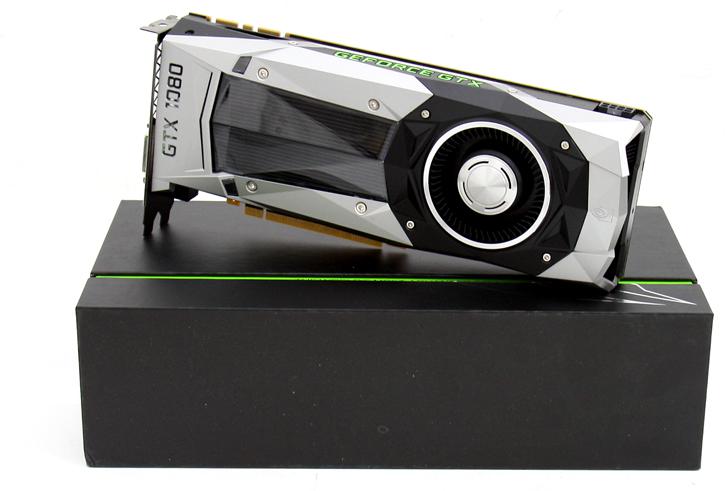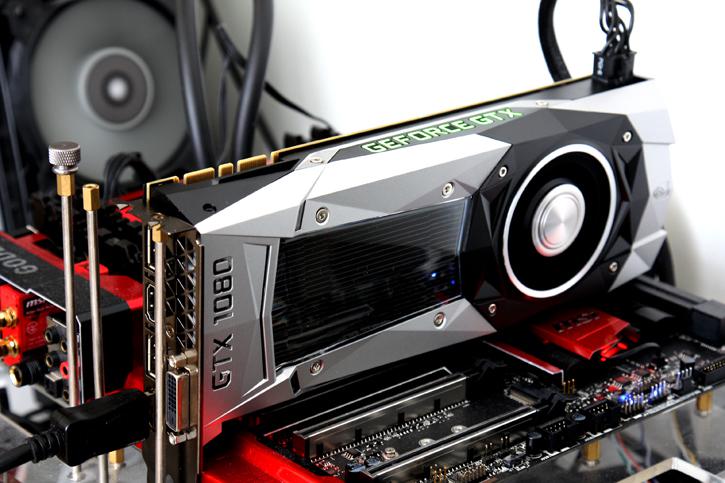Conclusion
Conclusion
It's been a long time coming for Nvidia, 20 nm failed and 16 nm just got nailed. The industry had to wait on a smaller fabrication node in the form of 16 nm with flappy winged transitors (FinFET). Puns aside, it is however surprising to see how well this node works out for Nvidia. To get the first consumer product out in the 1.6 GHz base clock range with a boost to the 1.7~1.8 Ghz domain, that's pretty terrific. But we all know that the true killah product will be the factory tweaked ones from the board partners. I suspect products with a base clock in the 1.8 GHz domain and a boost close to 2.0 GHz. So yet again you'll see another 20% performance straight outta da box compared to reference/Founders Editions. On the topic of the Founders Edition with a 100 USD price premium, let me just say this, it is a marketing fail for Nvidia. It was a bit ill-communicated and despite that, you do not price reference products (as premium as you claim them to be) 100 bucks over the AIB/AIC prices.
The Pascal GP104 architecture is interesting, as in aside from a few changes in the pipeline, it looks VERY similar to Maxwell. Make no mistake there have been changes, but it shares a very similar structure. So the biggest benefit for Nvidia was 16 nm, as it allows them to drive their products to incredible clock frequencies whilst they can use less voltage, and that results in power consumption under the 200 Watt marker. The next ticked box for GeForce GTX 1080 is GDDR5X, effectively it brought them a data-rate of 10 Gbps which brings in a very nice memory performance boost. Combined with the new color compression technologies they can effectively achieve 43% more bandwidth compared to the GeForce GTX 980. And I do bring up the GeForce GTX 980 with good reason, the GTX 1080 is to replace that product. However the 1080 is faster than the 980 Ti and faster then the Titan X. You really are looking at 20% to 40% performance increases depending on game title and resolution. So that is a huge step forward, and again... this is just the reference clocked product. The board partners are going to get crazy with this chip. I also need to applaud the step of moving towards 8 GB of graphics memory. Whilst the highest used we ever measured is in the 5 to 6 GB VRAM domain, that 8 GB 256-bit GDDR5X memory is an excellent and well-balanced amount of graphics memory. Keep in mind:
- Enthusiast level gaming requires a lot of graphics memory.
- People simply like gigantic graphics memory buffers.
So yes, the raw rendering performance versus that massive VRAM partition is going to attract a certain kind of people, the demographics would match a large chunk of the Guru3D.com reader-base. Honestly I can talk and explain why you should or shouldn't purchase a card like this, the fact remains people that can afford it will purchase it, people that can't or refuse to, won't. This is the Porsche that nobody can afford, but really likes (the Ferrari still needs to be released with Big Pascal). But hey, who knows with titles like The Division / GTA5 and technologies like Ultra HD and / or DSR versus performance and VRAM what you find valid, or not. High up there in the enthusiast space there certainly is a market for cards like these. That makes these 8 GB models relevant for gaming. And it really is a partition of 8 GB and not 7.5 GB of graphics memory :P Allow me to make this very last pun about it.
Price Tag - Jessie J - ft. B.o.B
The GeForce GTX is cool, very cool. Value wise however I do feel you probably should wait and see how the GeForce GTX 1070 is going to perform, it'll get the same GPU with slightly less shader processors active and regular GDDR5 memory. Thing is that Nvidia keeps driving the prices upwards. Typically the high-end class product hovers at the 500 USD marker. Nvidia, when they released it, drove the GTX 980 to 549 USD. The GTX 1080 now starts at 599 USD with the reference Founders Edition at a massive 699 USD. For the Founders Edition, that's pretty bad pricing if you ask me.
World prices then (suggested MSRP for Founders edition):
- Serbian Dinar RSD 96,900
- Czech Koruna CZK 21,400
- Danish Krone DKK 6,150
- Germany EUR 789
- France EUR 789
- British Pound GBP 619
- Hungarian Forint HUF 259,850
- Norwegian Krone NOK 7,599
- Polish Zloty PLN 3,599
- Romanian New Lei RON 3,499
- Russian Rouble RUB 54,990
- Indian Rupee INR 63,250
- Swedish Krona SEK 7,699
- Turkish Lira TRY 2,850
- South African Rand ZAR 13,599
- Switzerland CHF 790
- UAE AED 2,850
- USA USD 699
It has been an ongoing trend for a while now. And remember, this is not the enthusiast SKU, that'll be a GTX 1080 Ti / Titan like product and listen closely... the GTX 980 Ti (enthusiast class) started at 699 USD when released, the same price that Nvidia now launches their Founders Edition at. This is the conundrum and dilemma with the GeForce GTX 1080, not the performance, not the product... but the price level. So this is why I will make a strong remark about the upcoming GeForce GTX 1070. It'll be launched June 10th at a $379 MSRP and $449 for the reference Founders Edition. A very similar product with, again, 8 GB of memory albeit "regular" GDDR5 memory but still boasting over 2/3rd of the performance (6.5 TFOP/s) the GTX 1080 offers. Keep it in mind, that's all I'm sayin'. It's all about the money money money, right... Jessie?
Aesthetics
For the new 1080 series Nvidia tweaked the aesthetics of the cooler a bit as you now see triangles/polygons embedded on the cooler shell, resembling the core essence 3D objects are made of, of course. Being a very expensive card they probably should have considered making it a bit more mysterious looking with a black shell, especially at that 100 USD price premium for the Founders Edition GTX 1080. The GeForce GTX logo on top some might dislike, it surely doesn't bother me though and that see-through Plexiglass in the cooler makes it look quite nice. Overall it's just a good looking and sturdy product. We like the fact that it has a backplate though, but completely dislike the fact that it has no meshes and gaps for more ventilation on that backside. The design, as is, will trap heat. As you can see, I remain skeptical about backplates, they can trap heat and thus warm up the PCB. But the flip-side is that they do look better and can protect your PCB and components from damage.
Cooling & Noise Levels
The cooling itself really is at the same level it was, you can't really complain about it. A bit trivial of course remains the temperature targets that Nvidia is using. The default setting for the GTX 1070 and 1080 will be, give or take, 80 degrees C, meaning the card is allowed to run to 80 Degrees C before ramping up the fan RPM to try to keep the product cool at 80 Degrees C. Nvidia feels this is a nice balance in-between performance, power consumption and temperatures. Most of you would however prefer something a little lower. You can obviously change the temperature target of the fan RPM yourself, that will ramp up the noise levels though. But at roughly 80 degrees C and at that level the noise levels are okay really. In idle you can barely hear the cooling solution and under stress, well you can hear some airflow and that's it. The downside of a higher temperature allowance does effect the heating of the PCB, as you can see there is a lot of heat bleeding throughout the PCB. Including the VRM area, it however remains in the 80~85 degrees C range throughout the board, and that remains acceptable. Obviously you'll see like a million different and customized board partner designs with far better cooling.
Power Consumption
The GP104 Pascal GPU is rated as having a 180 Watt TDP under full stress, our measurements back that up, but we did stumble into some minor oddities. We can confirm your average 180 Watt TDP. But when running more viral applications like the FireStrike graphics test 1, we found the TDP had risen with a good dozen or so Watts. I've never found a good answer for that, but I can see that certain games would show similar behaviour. The GeForce cards these days are loaded with voltage-, clock- and power limiters... so much stuff is monitored real-time that even specific applications can behave differently. It will be interesting to learn what other media will report about their findings before I can make a more formal comment on this. Anyhow, at this performance level you are looking at a card that consumes roughly 450 Watts for a stressed PC in total, that is okay. We think a ~600 Watt PSU would be sufficient and, if you go with 2-way SLI, a 800~900 Watt power supply is recommended. Remember when purchasing a PSU, aim to double up in Wattage as your PSU is most efficient when it is under 50% load. Here again keep in mind we measure peak power consumption, the average power consumption is a good notch lower depending on GPU utilization. Also, if you plan to overclock the CPU/memory and/or GPU with added voltage, please do purchase a power supply with enough reserve. People often underestimate it, but if you tweak all three aforementioned variables, you can easily add 200 Watts to your peak power consumption budget as increasing voltages and clocks increases your power consumption.
Harder, Better, Faster, Stronger
We've got to go Daft Punk here as Harder, Better, Faster, Stronger does sum it up. But do you really need a card as beefy as the GeForce GTX 1080 really is though? Well, that depends on a rather abstract external factor, your monitor(s). If you game at a resolution of 1920x1080 (Full HD) then no, not really. However, more is better and with technologies like DSR (super-sampling) and Ultra HD the raw horsepower this card offers certainly isn't distasteful. Also, with with surround gaming (three monitors) the GeForce GTX 1080 will just make a lot of sense, especially with the new simultaneous multi-projection feature build into the rendering pipeline, that probably is one of the most innovative features Nvidia has added that I have seen in a long time. From 1080p to Ultra HD the GeForce GTX 1080 hauls the proverbial toosh compared to whatever other single GPU based graphics card you can name in existence. Obviously it is the fastest kid on the block. This much performance and graphics memory helps you in Ultra HD, hefty complex anti-aliasing modes, DSR and of course the latest gaming titles. I consider this to be among the first viable single GPU solutions that allows you to game properly in Ultra HD with some very nice eye candy enabled. However, I was kinda hoping to be closer to 60 FPS on average with the GTX 1080 in Ultra HD. But that will probably take the future Big Pascal (Ti / Titan). As always, drivers wise we can't complain at all, we did not stumble into any issues. And with a single GPU there's no micro-stuttering and no multi-GPU driver issues to fight off. Performance wise, really there's not one game that won't run seriously good at the very best image quality settings. Gaming you must do with a nice 30" monitor of course, at 2560x1440/1600 or Ultra HD. Now, we can discuss the advantages of an 8 GB framebuffer, but hey, you can draw your own conclusions there. At least you won't run out of graphics memory for the years to come right? So in that respect the card is rather future proof.
SLI then, we have to mention this. Starting with Pascal the primary focus for Nvidia in terms of multi-GPU setups is that they will support 2-way SLI, but really that's it and all. For those of you that want to run 3 and 4-way configuration, it's going to be difficult but remains possible as the game needs to support and you will need to obtain a driver key from the Nvidia website. Do not expect Nvidia to enhance drivers for it, they'll just open up the floodgate and have you deal with the rest. Personally I am okay with this choice. I have been complaining for years now that once you pass two card, you will almost exponentially faster run into some sort of driver issue and thus irritation. So yes, some of you might be disappointed about this news. Me personally, I am fine with the choice to focus on proper 2-way SLI opposed to all the arbitrary configurations that less then 0,01% of the end-users uses.
FCAT, frame pacing and frametime wise, wel have a separate article on that! Read that here.
Overclocking
We'll refrain from making comments on overclocking for now. We know the card can pass 2 GHz on the Boost frequency easily and the memory can reach 11 Gbps effecively. But overclocking at the moment is a mess and requires "specific" drivers and beta overclocking utilities. Once all OC tools are out that work with actual normal drivers we'll be happy to include proper results.
Concluding
It should go without saying that Nvidia has got a killah card here with the GeForce GTX 1080 and, as such, it does come recommended. This little spawn of the Devil himself offers terrific performance, and it offers a nice boost coming from the GTX 980 and is even a good notch faster compared to the 980 Ti and Titan X. However, if you have such a 980/980 Ti/Titan X you probably are not going to upgrade. It's the owners of the GPU generation before that or 970 and lower that will benefit from a product like this the most. The new architecture proves its agility and the die shrink to 16 nm FiNFET shows low power consumption due to lower voltages and obviously the high clock-speeds and that GDDR5X memory offer the complete package that the GTX 1080 is. Depending on street prices you can expect a 599 USD/EURO price tag if you steer away from the, what I find to be a too expensive, Founders Editon card. If you stick to the WHQD 2560x1440 domain this is the card that will last you years to come. For long-term Ultra HD usage (high FPS) however the answer still needs to be found in two cards. But hey, if WHQD is your domain then the GeForce GTX 1080 is a rather future proof product with that proper 8GB graphics memory. Obviously, and I already mentioned this clearly, that alone does not justify a price tag at this level, even the 599 USD/EURO price tag I find to be rather high for a product that needs to replace the GTX 980 as remember, this is a high-end, not enthusiast class product. We'll need to wait and see how severely the GeForce GTX 1070 is going to get limited (or not), Nvidia clearly did not share specs so they can adapt last minute to the media, market and consumer responses. But price/performance wise an 8 GB GeForce GTX 1070 will make much more sense at a starting price of 379 USD. Pricing aside, the performance level the 1080 offers, based on a single GPU configuration, simply is downright spectacular. Keep in mind that today we tested a Founders Edition card, the reference product. The board partners will ooze out factory tweaked products that might run 20% faster, and that's where things get really serious as far as I am concerned, just as long as that price doesn't shoot into the stratosphere. If you game at 2560x1440 (WQHD) then you are covered with 8 GB, it is just the perfect number for graphics memory if you ask me. The Founders Edition itself then, it's a great card that rocks hard and does so while hardly making any noise and stays at OK temperatures. You will be hovering at that familiar 80 degrees C under heavy load though. Armed with some new features like SMP (Simultaneous Multi-Projection) the Nvidia GeForce GTX 1080 is a great graphics card that will have no problem rendering away hard in the toughest PC games with grand image quality settings. For display output options you are covered for years to come as well. Price wise of course I said enough. And hey, I do have to remark this remains to be in the high-end domain. It's a product that will "love you long time" PC gaming wise, as all hardware variables tick the right boxes. Priced steep for sure, but definitely recommended and we cannot wait to see all the board partner cards. Well, that and the GeForce GTX 1070 of course :)
Hold it, you're not done Sir - we've got more Pascal GPU related content for you to read:
- GeForce GTX 1080 Founders reference review
- GeForce GTX 1080 FCAT Frametime Analysis
- GeForce GTX 1080 Overclock guide
- GeForce GTX 1070 Founders reference review
- GeForce GTX 1070 FCAT Frametime Analysis
Recommended Downloads
- Sign up to receive a notice when we publish a new article
- Or go back to Guru3D's front page




